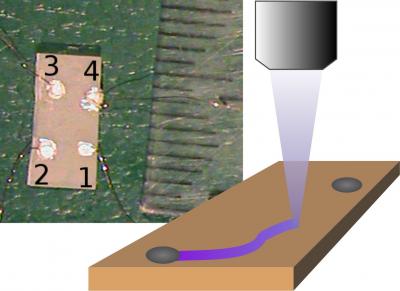Via: International Atomic Energy Agency (IAEA)
Posted in nuclear energy
Researchers from the University of Manchester have developed a new treatment that could limit the damage caused by strokes and also promote repair in the affected area of the brain. What’s more, the drug they’re using has already been clinically approved.

Washington State University (WSU) physicists have found a way to write an electrical circuit into a crystal, opening up the possibility of transparent, three-dimensional electronics that, like an Etch A Sketch, can be erased and reconfigured.
Ordinarily, a crystal does not conduct electricity. But when the researchers heated up crystal strontium titanate under the specific conditions, the crystal was altered so that light made it conductive. The circuit could be erased by heating it with an optical pen.
One of the greatest fears of the world’s space is a real-life Andromeda Strain, the chilling movie about a US research satellite carrying a deadly extraterrestrial microscopic organism that crashes into a small town in Arizona. A group of top scientists are hurriedly assembled in a bid to identify and contain the lethal stowaway.
But a British PhD candidate has warned of the darker side of a transhumanist future.
Sociologist Alex Thomas of East London University believes that transhumanism will further enforce a societal obsession with “progress” and “efficiency” at the expense of social justice and environmental sustainability. In an article published this week in The Conversation, Thomas argues that unbridled technological progress, in which technology “become more intrusive and integrate seamlessly with the human body”, could lead to a loss of basic societal values such as compassion and a concern for the environment.
Transhumanism and advanced capitalism are two processes which value “progress” and “efficiency” above everything else. The former as a means to power and the latter as a means to profit. Humans become vessels to serve these values. Transhuman possibilities urgently call for a politics with more clearly delineated and explicit humane values to provide a safer environment in which to foster these profound changes.”
Thomas interweaves examples ranging from new military technologies to powerful enhancement medications, arguing that, rather than assisting humanity, these technologies could potentially lead to a “mechanisation” of humanity and facilitate a subtle form of authoritarian control.
Breakthroughs in biometric science mean future troops will fight with weapons that understand them — inside and out.
Imagine a group of volunteers, their chests rigged with biophysical sensors, preparing for a mission in a military office building outfitted with cameras and microphones to capture everything they do. “We want to set up a living laboratory where we can actually pervasively sense people, continuously, for a long period of time. The goal is to do our best to quantify the person, the environment, and how the person is behaving in the environment,” Justin Brooks, a scientist at the Army Research Lab, or ARL, told me last year.
ARL was launching the Human Variability Project, essentially a military version of the reality- TV show Big Brother without the drama. The Project seeks to turn a wide variety of human biophysical signals into machine-readable data by outfitting humans and their environment with interactive sensors.
It is an industry like no other, with profit margins to rival Google – and it was created by one of Britain’s most notorious tycoons: Robert Maxwell. By Stephen Buranyi.